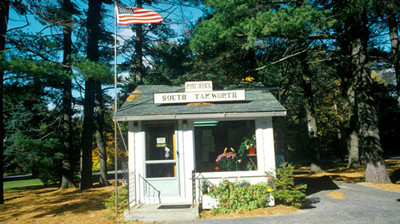邮政银行
Put your money where your mail is
邮件在哪儿,钱就在哪儿
America's postal service ponders a foray into financial services
美邮政业或将涉足金融业
WITH a workforce of just over 491,000 in 2013, the United States Postal Service is second only to Walmart among civilian employers in America. But it still employed more than 200,000 fewer people last year than it did just nine years earlier—when it handled nearly 500m more pieces of mail and had almost 2,000 more retail offices. The rise of e-mail has left America's massive postal service with far less to do, and it has been scrambling to find ways to raise revenue.
2013年,美国邮政服务公司雇员超过491000人,成为仅次于沃尔玛的美国第二大雇主。九年前美邮需要处理近5亿封邮件,拥有2000多个办事处,和那时相比去年还是减少了超过20万雇员。电子邮件的崛起导致美国大量的邮政服务没什么业务可做,他们开始寻求其他的收入增长点。

Earlier this year its inspector-general released a white paper suggesting that post offices should begin offering financial services, such as cheque-cashing, small loans, bill payments, international money transfers and prepaid cards to which salaries or benefits could be transferred. The reasoning is simple: a lot of Americans have scant access to banks and a lot of post offices have too little to do.
今年初,美邮总监发布的白皮书显示邮政业要开始提供金融服务,这些服务包括支票兑现,小额贷款,账单支付,国际转账以及能够预支的工资卡。这么做的原因很简单:许多美国人对银行的需求得不到满足而一堆邮局又无事可做。
More than one-quarter of American households are unbanked or underbanked, meaning they either lack a current or savings account, or they have one but still use alternatives to banks such as cheque-cashers and payday lenders. That is an expensive habit: the average underbanked household has an annual income of only $25,500 or so, yet spends around 9.5% of that on fees and interest charged by these banking substitutes.
超过四分之一的美国家庭没有银行账户或者没有得到充足的金融服务,这意味着他们没有这种倾向或者没有储蓄账户,也可能他们有账户,但选择如支票承兑人或发薪日贷款人等替代方式。这是种代价很高的习惯:一般来说没有银行账户的家庭年均收入25500美元,而支付给这种银行替代机构的费用和利息达到9.5%左右。
High-street banks find it hard to make money serving poor customers, since they tend to have little money on deposit that the banks can lend out. Penalties such as overdraft fees are not always enough to compensate. Since 2008, 93% of bank-branch closings have come in areas where median household income is below the national average.
大型银行为穷人提供服务很难赚到钱,因为他们的存款太少,而银行要把这些钱贷出去。透支费这种惩罚措施并不总是能够偿还成本。自2008年起,93%的支行陷入这样的境地—家庭账户收入的中值低于国家平均水平。
These are the distressed customers to whose rescue the USPS hopes to ride. Some 59% of its post offices are in places with either a single bank or none at all. In rural hamlets they are often one of very few commercial establishments; even in the postal service's diminished state, there are still more than seven post offices for every Walmart in America. Post offices already sell money orders and provide electronic remittances to nine Latin American countries; from 1911 to 1967 the USPS also held personal deposits. Providing small, brief loans at lower interest rates than payday lenders could save low-income consumers hundreds of millions or even billions of dollars in interest and fees. The post office would compete not with banks, but with their more expensive stand-ins.
正式这些贫穷的顾客点燃了美邮的希望。美邮59%的邮政所周围只有一家或者没有银行。在美国乡下,他们常常是为数不多的商业机构之一;即使是在邮政服务日益萧条的州,邮政所和沃尔玛的数量比也大于7:1。邮政所造就开始向9个拉丁美洲国家卖邮政汇票并提供电子汇款服务;1911年到1967年之间,美邮还有个人存款业务。提供利率比发薪日贷款人低的小额短期贷款,能为低收入客户节省数亿甚至数十亿美元的利息和费用。邮政局不是和银行竞争,而是在和比银行收费高的替代机构竞争。
Some, notably the head of the committee of the House of Representatives that oversees the USPS, are unconvinced. They see the postal services' expansion into financial services as government overreach, and a delay of the necessary “right-sizing” of a massive agency that does far less than it used to. Jennifer Tescher, who heads a charity focused on the underbanked called the Centre for Financial Services Innovation, notes that the USPS “has zero capacity, understanding or capability in this arena”. “The only asset they bring to the table”, she believes, “is distribution.” Even that is of limited value outside rural areas: Ms Tescher notes that just because a spot lacks bank branches does not mean it has no cheque-cashers and corner shops selling prepaid cards—many with longer and more convenient opening hours than the post office.
众议院委员会负责人指出美邮的做法明显不具信服力。他们把邮政业扩张到金融领域的行为视作政府的手伸的太长,认为这是在拖延这个远远低于过去功效的大型机构合理精简的步伐。一个专注于那些无法得到充分金融服务的人的慈善团体—金融服务创新中心的负责人詹妮弗说美邮不了解这一领域,既没资格也没能力。她相信美邮唯一的优势是渠道,即使这在农村以外地区基本没有价值。Tescher女士提到这些区域缺少银行网点并不意味着没有支票承兑人和贩卖预付卡的小店—和邮局相比,他们的营业时间更长、更方便。
Although turning the USPS into a part-time financial institution may seem outlandish in America, roughly 1 billion people in 50 countries rely on their postal systems for financial services, according to the Universal Postal Union, the United Nations agency that helps the post arrive on time. The business models vary widely. In some countries post offices act as a payment centre, allowing people to receive remittances, pay bills and top up or tap money stored on their mobile phones. Some operate full-service banks: Japan Post, for instance, is one of the world's biggest. In other countries, such as Brazil, commercial banks form partnerships with post offices; in Malawi private banks can rent space from post offices.
根据万国邮政联盟,尽管美邮成为兼职的金融机构在美国看起来很奇怪,但世界上50个国家的10亿人依靠邮政系统提供的金融服务。这种商业模式差别很大。在一些国家,邮局充当支付中心的角色,人们可以接收汇款、支付账单利用移动电话存取款。有一些则成为提供全面服务的银行:比如日本邮政就是世界上最大的银行之一。在像巴西一类国家,商业银行和邮政成为合作伙伴;在马拉维,私人银行能向邮局租借场地。
A World Bank study found last year that postal banks are likelier than conventional ones to provide accounts to those outside the financial mainstream. The bigger the postal network, the greater the ability to reach such people. That may not convince those who would like to see the USPS shrink, but for those who want to preserve it, it could help to justify its scale.
去年世界银行研究发现,相对于传统银行,邮政银行更有可能为主流金融区域之外的人提供服务。邮政网络越大,接触到这些人的能力就越大。这也许不足以说服那些希望美邮精简的人,但对于那些想要保持它的人来说,这能帮助他们证明美邮规模的合理性。












